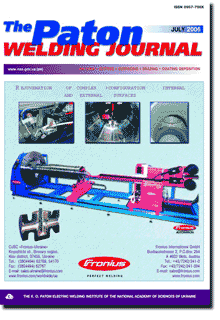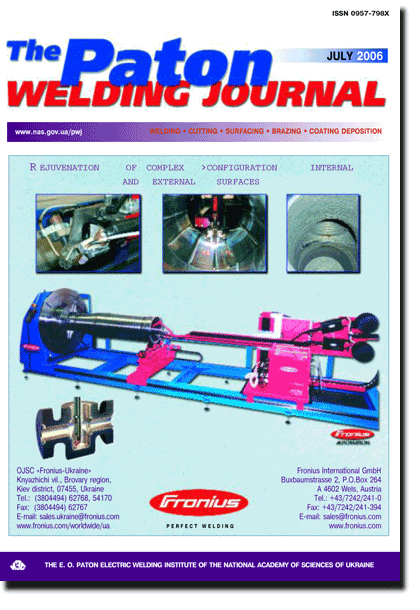

| SCIENTIFIC AND TECHNICAL | |||||||
| Paton B.E., Lobanov L.M., Samilov V.N., Pilishenko I.S., Makhnenko O.V., Pashchin N.A., Gorinov V.A. and ShiyanK.V. Design and features of fabrication technology of a large-sized transformable shell structure | 2 | ||||||
| Main principles of design of shell-type transformable structures intended for storage of liquid and loose products, such as fuel, water, grain, etc., are described. Calculation diagrams and results of calculation of the strength and robustness of structures, as well as their ability to resist service and wind loads are presented. The technology for assembly and welding of thin-walled joints in structures with long welds is described. | |||||||
| Portnov O.M. and Maksimov S.Yu. Numerical modelling of absorption of gases by deposited metal in wet underwater welding | 11 | ||||||
| Results of mathematical modelling of composition of atmosphere of a vapour-gas bubble and content of hydrogen and oxygen in the weld metal as a function of slag in wet underwater welding are given. The mathematical model is based on calculation of thermodynamic equilibrium in an isolated three-phase gas-slag-metal system. It is shown that atmosphere of the vapour-gas channel in a temperature range of 2000--2500 K consists of a water vapour and molecular hydrogen. | |||||||
| Kulik V.M. and Vasiliev V.G. Variations in structure and properties of HAZ metal in welded joints on steel 30KhGSA in arc treatment | 16 | ||||||
| Austenitic transformation of the HAZ metal in arc welding proceeds at increased temperature. Repeated austenising in arc treatment of hardened metal in a region of overheated HAZ occurs at an increased temperature, and its rapid heating leads to decrease in size of austenite grain. The hardening structure is restored, and properties similar to the initial ones are acquired in subsequent cooling. Heating of the hardened HAZ metal below results in short-term tempering, improvement of its impact toughness and cold crack resistance. The highest efficiency of the arc effect is achieved in heating of the HAZ metal within the intercritical temperature range. | |||||||
| Borisov Yu.S., Golnik V.F., Ipatova Z.G., Mits I.V., SaakovA.G. and Saakov V.A. Aluminoceramic plasma coatings | 22 | ||||||
| Aluminoceramic plasma coatings produced by spraying composite powders (mixture of aluminium and iron titanium) were developed. The plasma spraying process was proved to provide coatings containing intermetallic inclusions with microhardness of about 11000 MPa. Aluminoceramic coatings of composite powders with 35-45 wt.% FeO-TiO2 have a maximal adhesion strength (45-50 MPa), and those with 25 wt.% FeO-TiO2 have the highest resistance to gas-abrasive wear (at all attack angles). Corrosion current density of the coatings of composite powders with 45 wt.% FeO-TiO2 in sea water is minimal (4.0 107 A/cm2). Wear in sliding friction is 10 times lower for a friction pair (steel 30KhGSA + coating) with 45 wt.% FeO-TiO2. | |||||||
| Pokhmursky V.I., Student M.M., Ryabtsev I.A., SidorakI.I., Dzioba Yu.V., Dovgunyk V.M. and FormanekB. Influence of electric arc metallizing modes and compositions of applied flux-cored wires on structure and abrasive wear resistance of coatings | 26 | ||||||
| Studied is the influence of electric arc metallizing modes using flux-cored wire FMI-2 on the microstructure and abrasive wear resistance of the coatings. It is shown that among the many factors the compressed air pressure, current and spraying distance have the greatest influence on these characteristics. Wear resistance of coatings, deposited using flux-cored wire with the charge based on ferrochromium-boron, is higher than that of hardened steel. The highest wear resistance is found in coatings deposited at a high pressure of compressed air, which are characterized by finely dispersed structure and containing a large amount of the oxide phase on the interphases. | |||||||
| INDUSTRIAL | |||||||
| Thomy C., Kohn H. and Vollertsen F. Application of high-power fibre lasers in laser and laser-MIG hybrid welding | 31 | ||||||
| Latest developments in laser physics have enabled the production of high-power fibre lasers with beam powers up to 10kW at excellent beam quality. Adding to these properties their high energetic efficiency, their considerable estimated lifetime and their compact size, they might well be considered to be a viable alternative to both conventional lamp- or diode-pumped Nd:YAG- as well as to CO2-lasers. However, due to the novelty of the system, very few experiences on their usability for materials processing and in special for welding of steel and aluminium sheet material are existing. To help this situation, both a 7 kW and a 10 kW high-power fibre laser system have been tested by the Bremen Institute of Applied Beam Technologies (BIAS), and their potentials for welding steel and aluminium sheets have been assessed. By the help of these results for pure laser and laser-GMA hybrid welding, of which a selection is presented here, it could indeed be demonstrated that it is possible to remarkably enhance process limitations considering welding speed and sheet thickness previously regarded to be inevitable when welding with solid-state lasers. | |||||||
| Kalita W., Kolodziejczak P., Kwiatkowski L., Grobelny M. and Hoffman J. Properties of CO2-laser welded joints of dissimilar magnesium alloys | 34 | ||||||
| This paper provides the results of investigation that has been carried out on the keyhole laser beam welding of dissimilar magnesium alloys. Welding of workpieces of alloys of MgAlZn (brittle) and MgAlMn (ductile) groups has been performed with the CO2-laser of maximum power of 2.5 kW. With the chosen flow rate of helium shielding and the beam focal position set on the metal surface the welds with no defects and with nearly parallel boundaries were obtained. The analysis of microstructures of the joints, measurements of hardness distributions and the elemental distributions in the weld cross-sections allowed finding the changes due to beam action and recrystallization. The static tensile strength tests have permitted to determine the conditions when the joints of satisfactory mechanical properties could be acquired. The corrosion immersion tests are also reported. | |||||||
| Koehler G., Mueller G., Basler U., Dahms St., Luhn R., Kasch S. and Waechter S. Glass joining technologies and examples of their application | 38 | ||||||
| The Institute of Joining Technology and Materials Testing is active in studies of different joining methods (diffusion bonding, brazing, soldering, adhesive bonding, laser welding, etc.) aimed at producing permanent joints in different materials with low residual strains. They include optical and technical glasses (silicon glass, infrared materials, borosilicate glass, VK7), glass ceramics with low thermal expansion (CERAN, CERODUR), crystals (sapphire, CaF2, MgF2), high-temperature ceramics (Al2O3, SiC), and metals (unalloyed and alloyed steels, precious metals, magnesium and titanium alloys, non-ferrous metals). | |||||||
| Zaruba I.I., Dymenko V.V., Andreev V.V. and Shatan A.F. Power sources with improved performance for AC arc welding | 43 | ||||||
| Considered are the features of operation of AC power sources with thyristor control, providing a high stability of the process and quality of welded joint formation. Data are given on AC welding, including root welds of pipe butt joints. | |||||||
| BRIEF INFORMATION | |||||||
| Zhadkevich M.L., Tyurin Yu.N., Kolisnichenko O.V. and Mazunin V.M. On heating and acceleration of disperse particles with pulse plasma | 48 | ||||||
| Heat exchange between the shock-compressed layer of pulse plasma and nickel particle of 60 mm size was studied. Numerical analysis of the characteristics of pulse plasma formed in the plasma-detonation accelerator has been performed. Influence of various components of heat exchange at particle heating in pulse plasma has been determined. The influence is shown of radiation heat exchange on heating of discrete particles and sprayed surface. | |||||||
| Lankin Yu.N., Masalov Yu.A. and Bajshtruk E.N. Schematic for control of welding machine drives | 50 | ||||||
| A simple schematic has been developed for control of motors of welding machine drives. Its static characteristics are described and oscillograms of the drive acceleration braking are given. | |||||||
| Theses for a scientific degree | 52 | ||||||
| NEWS | Cooperation between PWI and Brazilian Welding Society | 54 | Developed at PWI | 30 | 42 51 | ||
(You are viewing the simplified file contents)
The cost of subscription/purchase order journals or individual articles
| Journal/Currency | Annual Set | 1 issue printed |
1 issue |
one article |
| TPWJ/USD | 384 $ | 32 $ | 26 $ | 13 $ |
| TPWJ/EUR | 348 € | 29 € | 24 € | 12 € |
| TPWJ/UAH | 7200 UAH | 600 UAH | 600 UAH | 280 UAH |
| AS/UAH | 1800 UAH | 300 UAH | 300 UAH | 150 UAH |
| AS/USD | 192 $ | 32 $ | 26 $ | 13 $ |
| AS/EUR | 180 € | 30 € | 25 € | 12 € |
| SEM/UAH | 1200 UAH | 300 UAH | 300 UAH | 150 UAH |
| SEM/USD | 128 $ | 32 $ | 26 $ | 13 $ |
| SEM/EUR | 120 € | 30 € | 25 € | 12 € |
| TDNK/UAH | 1200 UAH | 300 UAH | 300 UAH | 150 UAH |
| TDNK/USD | 128 $ | 32 $ | 26 $ | 13 $ |
| TDNK/EUR | 120 € | 30 € | 25 € | 15 € |
AS = «Automatic Welding» - 6 issues per year;
TPWJ = «PATON WELDING JOURNAL» - 12 issues per year;
SEM = «Electrometallurgy Today» - 4 issues per year;
TDNK = «Technical Diagnostics and Non-Destructive Testing» - 4 issues per year.


